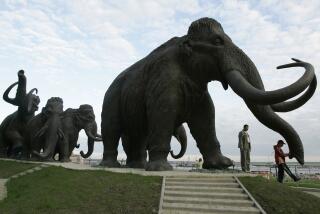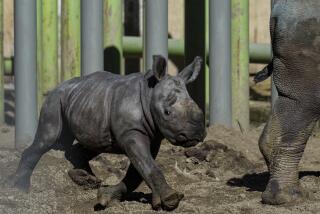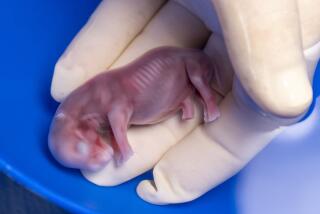How IVF might save northern white rhinos, the world’s most endangered species
- Share via
Perhaps no species on Earth is as close to extinction as the northern white rhinoceros.
The last male, known as Sudan, died in March at the age of 45. The two remaining females, Najin and Fatu, have been deemed infertile.
Still, researchers say it is too soon to write off the northern white rhino for good. Reproductive specialists may be able to create them in the lab.
In research published Wednesday, scientists show how techniques that help infertile couples conceive children could be put to use to save the critically endangered rhinos.
“If we have the technologies to save them, then why wouldn’t we try?” said Jan Stejskal, director of the Dvur Kralove Zoo in the Czech Republic, where Najin and Fatu were born. (They now reside in a 700-acre enclosure in Kenya, where they are protected 24 hours a day by armed guards.) “I don’t want to witness the disappearance of these animals right before our eyes just because we didn’t care enough to do something about it.”
Stejskal is part of the international team of scientists and conservationists trying to keep the rhinos from slipping into extinction.
Their report in the journal Nature Communications shows that unfertilized eggs harvested from closely related southern white rhinoceros females can be fertilized by frozen sperm previously collected from northern white rhino males.
The resulting embryos can grow for up to 13 days to the blastocyst stage, the point at which they could be implanted in the uterus of a surrogate female.
Barbara Durrant, director of reproductive sciences at the San Diego Zoo, said the in vitro fertilizationrepresents the first time that a rhino embryo created in the lab has gotten as far as the blastocyst stage.
“There have been a few rhino embryos that have been produced, but they haven’t developed as far as those created by the team that published this recent paper,” said Durrant, who wasn’t involved in the research.
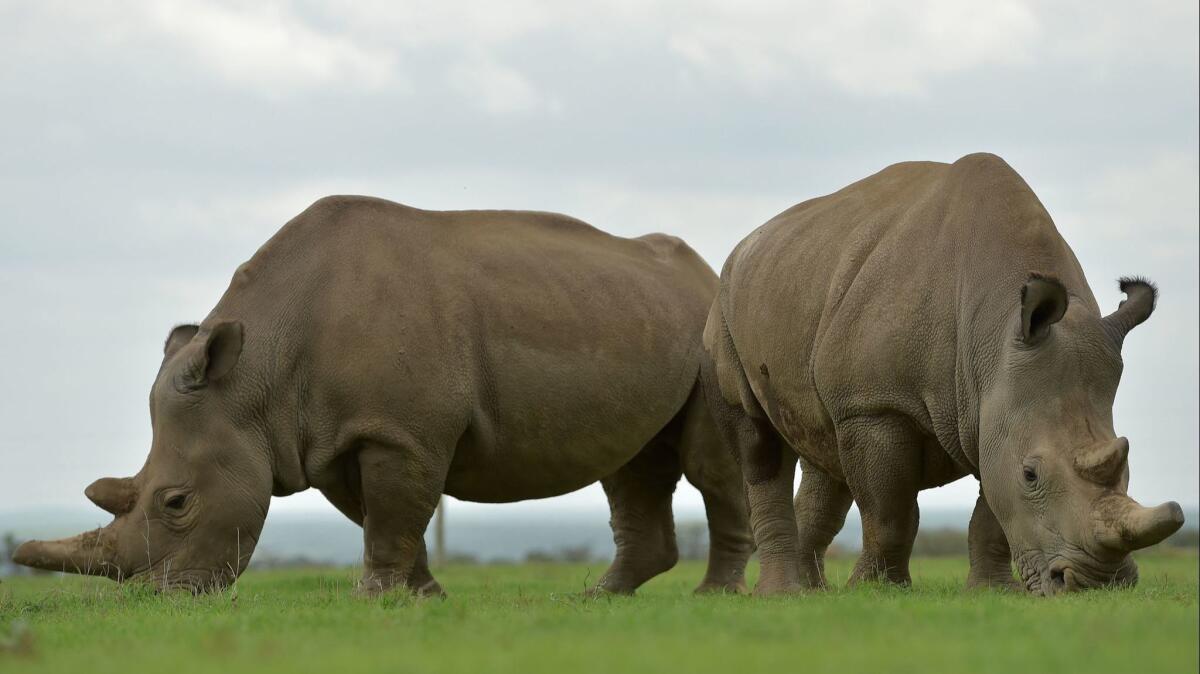
If the researchers can repeat their success with eggs from a northern white rhino female, then there’s hope for these animals after all.
But nothing is certain.
Even if the researchers manage to create a pure northern white rhino embryo — rather than the hybrid described in the paper — there’d still be several hurdles to clear before a calf could be born, experts said.
“The next big step is to see if we can transfer those embryos to a recipient mother, and then can they develop to a fetus, and then a healthy offspring,” said Pierre Comizzoli, a research scientist at the Smithsonian specializing in assisted reproduction, who did not work on the study.
Still, he said the study is “a huge contribution to basic embryology, and that is not trivial.”
The last male northern white rhino has died, spelling probable extinction for the species »
The idea that assisted reproductive technology might play a role in species conservation has been around since the 1970s. However, it has proved to be harder to execute than its early proponents anticipated.
This can be attributed to a few factors, said conservation scientists Terri Roth and William Swanson of the Cincinnati Zoo, who were not involved in the new research.
For example, reproductive physiology varies widely even among related animals. And because by definition, endangered species are rare, research subjects are few and far between, they wrote in a commentary that accompanies the study.
Only three vulnerable species have been aided by assisted reproduction, Roth and Swanson wrote. They are the black-footed ferret, the giant panda and the Asian elephant.
The only hope for the northern white rhino is to join that list.
Even to get to this stage in their research, the challenges have been immense, the study leaders said.
For starters, collecting unfertilized eggs is a harrowing business. Female white rhinoceros ovaries are located about 6.5 feet inside their bodies. In order to retrieve eggs, the researchers put the animal under anesthesia, then used an ultrasound machine to guide a long needle into her uterus, puncture her follicles and dislodge the eggs.
The authors performed 18 of these procedures on southern white rhinos in zoos across Europe, resulting in the collection of 83 eggs.
The next challenge was to achieve fertilization in the lab with frozen semen collected from three northern white rhino bulls. This wasn’t easy either; the semen is of poor quality, and there isn’t much of it — just 300 milliliters, or a little more than one cup.
Early attempts were disappointing, but the results improved dramatically when they zapped the eggs with two electrical pulses just after the sperm injection.
Now that scientists know they can reliably collect eggs from female white rhinos, and that northern white rhino sperm can fertilize a white rhino egg in the lab, the next step is to go to Kenya and harvest eggs from the last two northern white rhinos on Earth.
Stejskal, of the Dvur Kralove Zoo, said the group has not yet received permits from the Kenyan government to do this work, but he is hopeful they will have them by the end of the year.
“They have formally said they will give us the necessary support,” he said.
After that, the plan is to create a northern white rhino embryo in the lab and implant it in a healthy southern white rhino surrogate, said study leader Thomas Hildebrandt of the Leibniz Institute for Zoo and Wildlife Research in Germany.
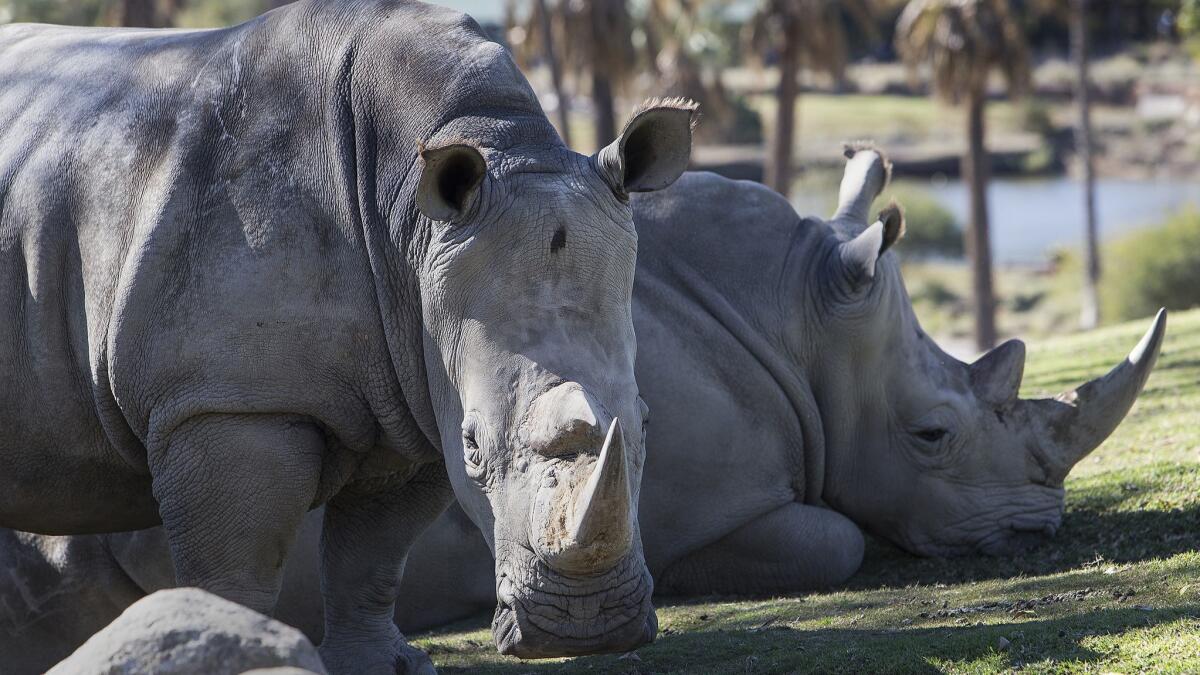
“Our goal is to have a northern white rhino calf on the ground in three years,” he said. “They have a 16-month pregnancy, so that gives us a little more than a year to have a successful implantation.”
The short timeline is necessary, he said, so that a baby northern white rhino could be socialized by members of its own subspecies.
It’s an ambitious goal, but Durrant said it could be a possibility.
“I think it is feasible, but they’ll have to hurry,” she said.
There are still unknowns.
Fatu is 18 and her mother, Najin, is 29. It is not certain whether their eggs are viable, and researchers say neither one is healthy enough to carry a pregnancy.
That means a southern white rhino would have to serve as a surrogate, and no one knows whether a southern white rhino can carry a northern white rhino baby. The two subspecies are related, but they have been geographically separated for a long time, Durrant said.
It is possible that in the future, a female that’s a hybrid of the northern and southern rhinos could carry a fully northern white rhino baby to term.
In addition, researchers at the San Diego Zoo Institute for Conservation Research and the Scripps Research Institute are trying to create pluripotent stem cells using skin cells taken from a dozen northern white rhinos. If they succeed, they can use the cells to produce eggs and sperm that could add enough genetic diversity to the northern white rhino population for it to be sustainable in the wild.
“A single northern white rhino calf would be a wonderful scientific achievement, and a hope for the future, but that is not the end goal,” Durrant said. “We want to see these animals revived and put back in their habitat.”
Do you love science? I do! Follow me @DeborahNetburn and “like” Los Angeles Times Science & Health on Facebook.
MORE IN SCIENCE
The koalas are threatened. Can their genome help us save them?
With Very Large Telescope, astronomers spy a planet being born around a young star
Struggling bumblebees can thrive in an unlikely place: The city
